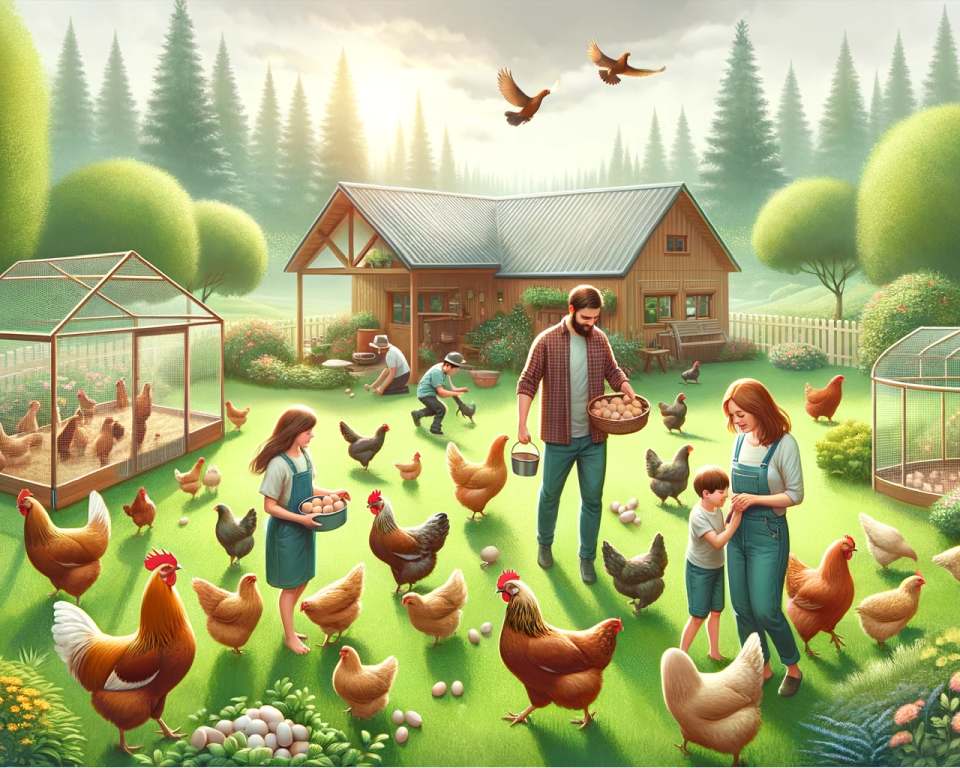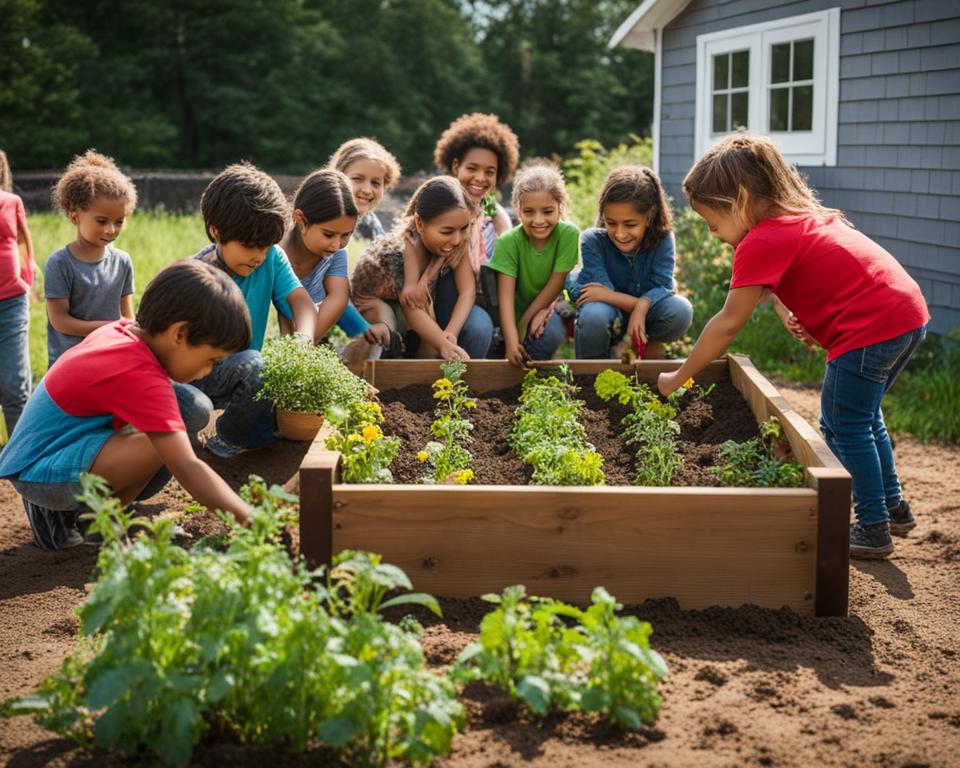The Homesteading Family: Insights and Inspirations
Welcome to our article on homesteading family life, where we delve into the insights and inspirations that can be gained from this rewarding way of life. Homesteading promotes self-sufficiency, sustainable living, and a deep connection to nature. Join us as we explore various aspects of homesteading, including tips for sustainable living, organic gardening, raising animals, preserving food, and more.
Homesteading offers a plethora of benefits for families. By embracing self-sufficiency and sustainable living practices, families can reduce their dependence on external systems, strengthen their bond with nature, and foster a sense of resilience and resourcefulness. The rural lifestyle provides valuable opportunities for children to learn essential life skills and develop a profound connection to the land.
Throughout this article, we will explore practical tips and techniques for sustainable living on the homestead, such as eco-friendly practices, reducing waste, and utilizing renewable energy sources. We will also delve into the world of organic gardening, raising animals, preserving food, homeschooling on the homestead, and embracing an off-grid lifestyle.
Join us on this journey as we uncover the immense possibilities and rewards of homesteading family life. Whether you are a seasoned homesteader or just beginning to explore this lifestyle, we hope to inspire and empower you with valuable insights and knowledge.
The Benefits of Homesteading Family Life
Homesteading offers numerous benefits for families. By embracing self-sufficiency and sustainable living practices, families can reduce their dependence on external systems, strengthen their bond with nature, and foster a sense of resilience and resourcefulness.
The rural lifestyle provides a unique opportunity for families to connect with the land and experience the rewards of living close to nature. Children growing up on a homestead develop valuable life skills and learn the importance of hard work, responsibility, and self-reliance.
“Homesteading allows us to break free from the fast-paced and consumer-driven society, and instead, focus on the things that truly matter – family, nature, and sustainable living.”
By living in a rural area, families can enjoy the peace and tranquility of the countryside, away from the hustle and bustle of the city. The homesteading lifestyle encourages families to spend quality time together, fostering stronger family connections and creating lasting memories.
Through homesteading, families can create a more meaningful and fulfilling way of life. The satisfaction of growing your own food, raising animals, and being self-sufficient is unparalleled. Homesteading provides a sense of purpose, accomplishment, and fulfillment that can be difficult to find in a modern, fast-paced society.
Key Benefits of Homesteading Family Life:
- Self-sufficiency and reduced dependence on external systems
- Stronger bond with nature and the land
- Opportunities for children to learn valuable life skills
- Peaceful and fulfilling rural lifestyle
- Enhanced family connection and quality time together
Embracing the homesteading lifestyle allows families to live in harmony with the environment, cultivate resilience, and create a sustainable future for themselves and future generations.
Practical Tips for Sustainable Living on the Homestead
Sustainable living lies at the heart of homesteading, guiding us to make choices that are both eco-friendly and beneficial for our families. By incorporating practical and mindful practices, we can reduce our environmental impact while creating a more self-sufficient and sustainable homestead. Here are some tips to help you embrace a more sustainable lifestyle:
1. Reduce Waste
Reducing waste is a fundamental aspect of sustainable living. Implementing measures such as recycling, composting, and avoiding single-use plastics can significantly minimize our environmental footprint. By prioritizing waste reduction, we can contribute to a healthier planet and inspire others to do the same.

2. Embrace Renewable Energy
Transitioning to renewable energy sources like solar panels is a fantastic way to harness the power of nature while reducing reliance on traditional energy grids. By investing in renewable energy, we can make our homesteads more self-sufficient and decrease our carbon footprint.
3. Practice Water Conservation
Water is a precious resource, and conserving it is crucial for sustainable living. Implement techniques such as rainwater harvesting, installing efficient irrigation systems, and repairing leaks promptly. By managing water usage responsibly, we can protect this valuable resource and ensure its availability for future generations.
4. Choose Eco-Friendly Products
Opting for eco-friendly products such as biodegradable cleaning supplies and natural personal care items is another way to promote sustainable living. By making conscious choices, we support businesses that prioritize environmental responsibility and contribute to a healthier planet.
5. Grow Your Own Food
Creating a home garden to grow your own food is a fantastic way to practice sustainable living. By cultivating organic produce, you can reduce reliance on store-bought goods, save money, and enjoy the satisfaction of eating fresh and homegrown ingredients. It also promotes a deeper connection with nature and healthier eating habits.
Implementing these practical tips for sustainable living will not only benefit the environment but also enhance your homesteading experience. By living in harmony with nature and adopting eco-friendly practices, you can create a thriving and self-sufficient homestead while inspiring others to do the same.
Organic Gardening for the Homesteading Family
Organic gardening is a vital aspect of homesteading family life. By growing our own food, we can enjoy the benefits of fresh, nutrient-rich produce while reducing our reliance on store-bought goods. Organic gardening not only provides us with homegrown food but also promotes a deep connection to the land and enables us to eat healthier and more sustainably.
When it comes to organic gardening, there are several key principles and techniques that homesteading families can embrace. One such approach is permaculture, which involves designing sustainable and self-sufficient ecosystems. By incorporating permaculture design principles in our gardens, we can maximize productivity, enhance biodiversity, and minimize waste.
Companion planting is another essential technique in organic gardening. By strategically pairing compatible plants, we can create mutually beneficial relationships that promote healthy growth and natural pest control. For example, planting marigolds alongside vegetables can help repel pests and attract beneficial insects.
In addition to permaculture and companion planting, homesteading families can utilize natural pest control methods. Instead of relying on chemical pesticides, we can introduce beneficial insects like ladybugs and lacewings, which feed on garden pests. Additionally, creating habitat for birds and bats can help control insect populations organically.
To help visualize the beauty and potential of an organic vegetable garden, take a look at the image below:
By practicing organic gardening, homesteading families not only ensure the quality of their food but also contribute to a healthier environment. By avoiding synthetic fertilizers and pesticides, we reduce water pollution and protect beneficial insects and wildlife. Furthermore, organic gardening allows us to create a sustainable and self-sufficient food system right in our own backyard.
Raising Animals on the Homestead
Many homesteading families choose to raise their own animals as an integral part of their sustainable lifestyle. With a focus on self-sufficiency and animal care, raising livestock on the homestead offers numerous benefits. Let’s explore the different animals that families commonly raise and the value they bring to the homesteading experience.
Backyard Chickens: A Sustainable Source of Eggs and Meat
One popular choice for homesteading families is raising backyard chickens. These feathered friends provide a sustainable source of fresh eggs and high-quality meat. Chickens are relatively easy to care for, requiring minimal space and offering a valuable learning experience for children. Their natural behaviors, such as scratching the ground and foraging, contribute to a healthier ecosystem in the backyard.

Not only do backyard chickens provide nutritious food, but they also offer companionship and an opportunity for children to learn about responsibility and animal care. Plus, the colorful variety of chicken breeds adds charm to the homestead environment.
Beekeeping: Enhancing Pollination and Harvesting Delicious Honey
Beekeeping is another rewarding activity for homesteading families. By hosting beehives on their property, families can enhance pollination in their gardens, leading to improved crop yields and better biodiversity. Bees play a vital role in the ecosystem by transferring pollen from flower to flower, enabling fruit and vegetable plants to reproduce.
Aside from their impact on the garden, honeybees produce delicious honey. Homesteading families can harvest their own honey, enjoying the sweet rewards of their hardworking bees. Additionally, beeswax can be used for crafting natural products such as candles and balms.
Additional Livestock Options and Proper Animal Care
In addition to chickens and bees, homesteading families may consider raising other livestock depending on their space and needs. Goats are excellent for milk production, fiber, and land clearing. Rabbits offer a sustainable source of meat and fur. Pigs can be raised for pork or utilized for land preparation. Each animal brings its unique contributions to the homestead.
Proper animal care and welfare are of utmost importance when raising livestock. Providing adequate shelter, clean water, nutritious feed, and regular veterinary care are vital for their well-being. Homesteading families should also prioritize the ethical treatment of animals, ensuring their comfort and respecting their natural behaviors.
“By raising animals on the homestead, we not only attain a sustainable food source, but we also cultivate a deeper connection to nature and a greater understanding of the food we consume.”
The experience of raising animals on the homestead goes beyond the practical benefits. It allows families to develop a profound appreciation for the source of their food and the role animals play in sustainable living. By raising animals, we foster a sense of responsibility, respect for nature, and a more sustainable way of life.
Next, we’ll explore the importance of preserving food for year-round nourishment on the homestead.
Preserving Food for Year-round Nourishment
Preserving food is an essential skill for homesteading families to ensure year-round nourishment. By utilizing various methods of food preservation, such as canning, fermenting, dehydrating, and root cellaring, families can prolong the shelf life of their harvest and enjoy the flavors and nutrients of fresh food throughout the year.
One popular method of food preservation is canning, which involves sealing food in airtight jars or cans to prevent spoilage. Canned goods can be stored for extended periods without the need for refrigeration. This method is particularly useful for preserving fruits, vegetables, and even homemade jams and jellies.
Another method is fermenting, where beneficial bacteria or yeasts are utilized to convert sugars into acids or alcohol. Fermentation not only extends the shelf life of food but also enhances its flavor and nutritional value. Examples of fermented foods include sauerkraut, kimchi, pickles, and yogurt.

For those looking to preserve food without using electricity, dehydration is a viable option. Dehydrating removes moisture from fruits, vegetables, and herbs, inhibiting the growth of bacteria and mold. Dried foods can be stored in airtight containers and rehydrated as needed. Dehydrated snacks, such as fruit chips or jerky, are popular choices among homesteading families.
Additionally, root cellaring is a traditional method that utilizes cool and humid underground or basement storage areas. Root vegetables, such as potatoes, carrots, and onions, can be stored in bins layered with sand or sawdust to maintain proper humidity levels and prevent sprouting or decay.
Preserving food through canning, fermenting, dehydrating, and root cellaring allows homesteading families to extend the availability of fresh produce and enjoy a wide variety of homegrown or locally sourced meals throughout the year.
Whether it’s stocking up the pantry with jars of homemade tomato sauce, fermenting a batch of tangy sauerkraut, or drying herbs for flavorful seasoning, preserving food ensures that the homestead provides sustenance even during the lean seasons.
Benefits of Food Preservation Methods:
- Canning: Extends shelf life without refrigeration.
- Fermenting: Enhances flavor and nutritional value.
- Dehydrating: Enables long-term storage without electricity.
- Root Cellaring: Maintains proper humidity levels for root vegetables.
By mastering food preservation techniques, homesteading families can reduce food waste, save money, and maintain a more self-sufficient and sustainable lifestyle. It allows them to fully enjoy the fruits of their labor and the abundance of the harvest throughout the year.
Homeschooling on the Homestead
Homeschooling is a popular choice for many homesteading families as it aligns with our values of self-sufficiency and hands-on learning. On our homestead, we believe that education goes beyond the classroom, and the entire homestead becomes a rich learning environment for our children.
Through homeschooling, we have the freedom to tailor our children’s education to their individual needs and interests, ensuring they receive a well-rounded and personalized learning experience. We integrate academic subjects with practical skills, allowing our children to develop a strong foundation of knowledge while also gaining hands-on experience in various homesteading activities.
One of the greatest advantages of homeschooling on the homestead is the opportunity for our children to explore nature and develop a deep connection to the land. They can observe the changing seasons, study local flora and fauna, and learn about sustainable practices firsthand. This nature-based education fosters a greater appreciation for the environment and instills a sense of responsibility towards the planet.
When our children participate in the daily chores and tasks on the homestead, they learn valuable life skills and develop a strong work ethic. From tending to the garden and caring for animals to building structures and preserving food, every activity becomes a hands-on learning opportunity.

Homeschooling on the homestead allows our children to learn at their own pace while following their passions and interests. It fosters a love for learning and encourages them to take ownership of their education. We believe that by empowering our children to become lifelong learners, we are equipping them with the skills and knowledge they need to thrive in the world.
As homeschooling parents, we continuously seek out resources and materials that support our children’s education. We incorporate a variety of curriculum options, educational websites, and community resources to ensure a well-rounded learning experience. We also actively engage with other homeschooling families to share ideas, tips, and support one another on this rewarding journey.
Homeschooling on the homestead may present its share of challenges, but the rewards far outweigh the difficulties. We witness firsthand the growth, curiosity, and joy our children experience as they explore the world around them and develop a deep connection with nature. Homeschooling empowers us as parents to guide and nurture our children’s education, providing them with a solid foundation and a love for learning that will last a lifetime.
Embracing an Off-Grid Lifestyle
Living off-grid is an intentional choice made by many homesteading families seeking self-reliance and a more sustainable way of life. By generating our own power through renewable energy sources like solar or wind, we can reduce our reliance on the grid and minimize our environmental impact. Off-grid living empowers us, as homesteading families, to assert our self-reliance and take control of our energy consumption.
One of the key elements of an off-grid lifestyle is harnessing renewable energy. Through the installation of solar panels or wind turbines, we can harness the power of the sun and wind to generate electricity for our homes and farms. This not only allows us to live more sustainably but also reduces our dependence on fossil fuels. By embracing renewable energy, we contribute to a cleaner and greener future for our planet.
But an off-grid lifestyle goes beyond just generating energy. It involves implementing sustainable infrastructure that supports our self-reliant way of life. For example, composting toilets not only reduce water usage but also create valuable fertilizer for our gardens. Rainwater harvesting systems allow us to collect and store water for various household needs, reducing our reliance on external water sources.
Living off-grid allows us to disconnect from external systems and create a more independent and sustainable homestead. It gives us the freedom to be in control of our resources and reduces our impact on the environment.
“We have embraced an off-grid lifestyle on our homestead, and it has been a transformative experience. We feel a deep sense of empowerment and satisfaction knowing that our energy needs are met by renewable sources. Living off-grid has brought us closer to nature and allowed us to live in harmony with the land.” – The Jones Family
Embracing an off-grid lifestyle requires resourcefulness, adaptability, and a commitment to sustainable living. It challenges us to find innovative solutions and encourages us to live more consciously, considering the impact of our choices on the environment. Through off-grid living, we can create a more resilient and sustainable future for our families and generations to come.
Overcoming Challenges in the Homesteading Journey
Homesteading is not without its challenges, but with resilience and problem-solving skills, we can overcome them. From harsh weather conditions to resource management, homesteading families learn to adapt and find innovative solutions. These challenges test our determination and push us to grow both as individuals and as a family.
Harsh weather conditions, such as extreme temperatures or storms, can pose significant challenges on the homestead. However, by implementing appropriate infrastructure, such as sturdy shelters, windbreaks, and insulation, we can mitigate the impact of these weather events. Additionally, utilizing alternative heating and cooling methods, such as wood stoves or passive solar design, can help us maintain a comfortable living environment.
“Weather challenges remind us of our interconnectedness with nature. It forces us to observe, adapt, and prepare for the unpredictable. Through each storm, we develop a deeper appreciation for the resilience of the natural world and our own ability to thrive amidst adversity.”
Managing resources on the homestead requires careful planning and problem-solving. Whether it’s water conservation, soil fertility, or energy usage, we strive to find sustainable solutions. Implementing rainwater harvesting systems, composting toilets, and efficient irrigation methods can help us optimize resource usage and reduce waste.
Community support plays a vital role in overcoming homesteading challenges. Connecting with like-minded individuals and local networks provides valuable resources, advice, and encouragement. Whether it’s attending workshops, joining online forums, or participating in local homesteading groups, we can learn from others’ experiences and gain valuable insights. Building these connections ultimately strengthens our resilience and helps us navigate the obstacles that come our way.
To illustrate the value of community support, I’d like to share a quote from fellow homesteader Jane Sullivan:
“Community support has been the backbone of our homesteading journey. There’s always someone who has faced similar challenges or has a creative solution to share. Together, we’ve created a network of resilience, where everyone’s success fuels others’ inspiration.”
By embracing challenges as learning opportunities, we grow in resilience and problem-solving skills. Each hurdle we overcome strengthens our homesteading journey and deepens our connection to the land. Together, with our community, we forge stronger bonds and a greater sense of belonging. Through shared experiences and mutual support, we thrive as homesteading families.

Building a Community of Homesteading Families
Homesteading is more than just a way of life. It’s a thriving community where like-minded families can come together, support one another, and share their experiences. By connecting with other homesteading families through local groups, online forums, and workshops, you can tap into a valuable support network that can guide and encourage you on your homesteading journey.
Through this community of homesteading families, you have the opportunity to exchange knowledge, ideas, and resources. Shared experiences and lessons learned provide a wealth of information that can help you navigate the challenges and rewards of homesteading. Whether it’s advice on organic gardening techniques, tips for raising animals, or recommendations for sustainable living practices, the knowledge exchange within the community empowers you to make informed decisions for your homestead.
“The homesteading community has been invaluable in my journey. From connecting with experienced homesteaders to participating in workshops, I’ve gained inspiration, learned new skills, and found unwavering support. It’s a network built on shared passion and a desire for self-sufficiency.”
Building a community of homesteading families not only provides practical guidance but also creates a sense of belonging. Knowing that you’re not alone in this endeavor can bring comfort and motivation, especially during challenging times. The shared commitment to a self-sufficient and sustainable lifestyle fosters a strong bond within the community, where you can find lifelong friends and mentors who understand the unique joys and struggles of homesteading.
Conclusion
In conclusion, homesteading family life offers a unique and fulfilling way of living that promotes sustainable practices, self-sufficiency, and a deep connection to nature. By embracing organic gardening, raising animals, and preserving food, families can create a self-sufficient and resilient lifestyle. The homestead becomes a place where children can learn valuable skills and develop a love for the land.
Homeschooling on the homestead further enhances the homesteading experience, allowing families to tailor education to their children’s individual needs and interests while fostering a strong sense of independence. Embracing an off-grid lifestyle through renewable energy sources and sustainable infrastructure allows families to reduce their environmental impact and live more independently.
While challenges may arise, the support of a homesteading community and the resilience of the family are vital in overcoming them. Building a network of like-minded individuals provides invaluable resources, advice, and encouragement. Through homesteading, families can cultivate a deeper connection to nature, build valuable skills, and create a meaningful and fulfilling life centered around the principles of sustainable living and self-sufficiency.
FAQ
What is homesteading?
Homesteading is a way of life that promotes self-sufficiency, sustainable living, and a connection to nature. It involves cultivating a piece of land to provide for the needs of a family, including growing food, raising animals, and preserving resources.
What are the benefits of homesteading family life?
Homesteading offers numerous benefits for families, including reducing dependence on external systems, strengthening the bond with nature, fostering resilience and resourcefulness, and providing valuable life skills and a connection to the land for children.
How can we practice sustainable living on the homestead?
Sustainable living on the homestead involves adopting eco-friendly practices such as reducing waste, composting, recycling, and using renewable energy sources like solar panels. Water conservation techniques like rainwater harvesting and efficient irrigation systems can also be implemented.
How can we start organic gardening on the homestead?
Organic gardening on the homestead involves learning about permaculture design principles, companion planting, and natural pest control methods to create a thriving vegetable garden. It allows families to grow their own food, reduce reliance on store-bought goods, and eat healthier and more sustainably.
What animals can we raise on the homestead?
Homesteading families can raise a variety of animals on their homestead, including backyard chickens for eggs and meat, bees for pollination and honey, and other livestock such as goats or rabbits depending on available space and specific needs.
How can we preserve food on the homestead?
Food preservation on the homestead can be done through methods such as canning, fermenting, dehydrating, and root cellaring. These techniques allow families to save the harvest from their gardens or purchase locally sourced produce in bulk, ensuring year-round nourishment with homegrown or locally sourced meals.
Is homeschooling a common choice for homesteading families?
Yes, homeschooling is a popular choice for many homesteading families as it aligns with their values of self-sufficiency and hands-on learning. Homeschooling on the homestead allows families to tailor education to their children’s individual needs and interests, fostering a love for learning and a strong sense of independence.
What does off-grid living entail for homesteading families?
Off-grid living for homesteading families involves generating their own power through renewable energy sources like solar panels or wind turbines, reducing reliance on the grid and decreasing their environmental footprint. Implementing sustainable infrastructure, like composting toilets and rainwater harvesting systems, further enhances the off-grid lifestyle.
What challenges can homesteading families face, and how can they overcome them?
Homesteading comes with challenges such as harsh weather conditions and resource management. However, families can overcome these challenges by developing resilience, problem-solving skills, and seeking support from like-minded individuals and local networks. Embracing challenges as learning opportunities is key to growing in resilience and forging stronger connections with the community.
How can homesteading families build a sense of community?
Homesteading families can connect with like-minded individuals through local groups, online forums, and workshops. By sharing experiences, knowledge, and resources, families can learn from one another and find support in their homesteading journey. Building a community of homesteading families creates a sense of belonging and fosters a supportive network that provides invaluable guidance and encouragement.







